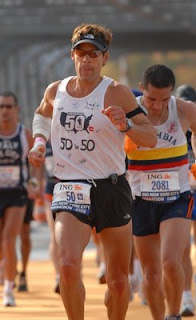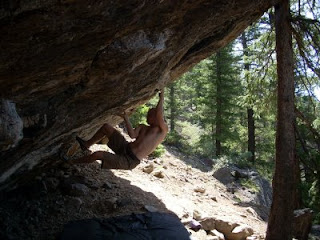Last spring I had the pleasure of meeting
Dean Karnazes when he was on his 50 marathons, in all 50 states, in 50 consecutive days. After completing that, you can bet that when Dean Karnazes says he’s going to the desert, he’s not talking poolside in Palm Springs.
Karnazes, a 1981 graduate of San Clemente High now living in San Francisco, set out this year to run 1,000 kilometers across some of the hottest, coldest, driest and windiest places on Earth.

Known worldwide as the Ultramarathon Man, Dean Karnazes was declared the winner of a worldwide event dubbed
The 4 Deserts. The "race" is an annual series of 250-kilometer races, each spread over six days, in stages. This year’s runners crossed the Atacama Desert in Chile, the Gobi in China, the Sahara in Egypt and what race organizers termed The Last Desert, Antarctica.
“The highlight,” Karnazes said, “was stepping off the boat in Argentina, safe. On the passage home (from Antarctica) we got stuck in hurricane-strength winds and a horrible storm. It was hairy. The boat right behind us ran aground and didn’t make it back.”
The weather for the six-day Antarctic race had started out nice enough, but it turned so nasty that the organizers, Racing the Planet, Ltd., had to cancel the final two days.

This wasn’t Karnazes’ first time in Antarctica. In 2002 he won the South Pole Marathon, a 26-mile race in -40 temperatures.
How was this month’s race different? “We were on the coastline this time, and there was actually life,” Karnazes said. “At the South Pole, there’s nothing alive. (Here) I was interacting with penguins that were incredibly curious, almost like cats. They come right up to you. I finished one of the stages, and I’d be sitting there and they’d be surrounding you. They have no natural predators, so they’re not intimidated.”
Karnazes, 46, found the 4 Deserts series more demanding than he had expected. For each day’s race, competitors had to carry everything they might need in a backpack. “It was pretty raw,” Karnazes said. “In the Sahara I thought, if you go down here, it could be three or four hours before someone comes upon you. It got up to about 112 or 113 on one of the days.”
Karnazes won the first race, in Chile. Crossing the Gobi, in China, on the border of Tibet, he ran into inquisitive kids. “It was some of their first exposures to westerners,” he said, “and here we were running through their villages.”
Arriving in the Sahara, Karnazes had heard about singing sand dunes and got to experience them. “It sounds like angels singing off in the distance,” he said. “You’re out there by your lonesome. It’s eerie, but kind of magical in a way. Finishing next to the pyramids was tremendous.”
Karnazes and Paul Lieberberg from South Africa were the first to complete all four events in the same year. Learn more at
Racing the Planet.










